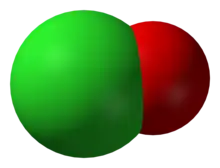
Hypochlorite (ClO−)
A hypohalite is an oxyanion containing a halogen in oxidation state +1. This includes hypoiodite, hypobromite and hypochlorite. In hypofluorite (oxyfluoride) the fluorine atom is in a −1 oxidation state.
Hypohalites are also encountered in organic chemistry, often as acyl hypohalites (see the Hunsdiecker reaction). Sodium hypohalite is used in the haloform reaction as a test for methyl ketones.[1]
Structure
The Cl-O bond length in crystalline sodium hypochlorite pentahydrate, NaOCl·5H2O, is 1.686 Å, while in sodium hypobromite pentahydrate, NaOBr·5H2O, the Br–O bond length is 8% longer at 1.820 Å.[2]
References
- ↑ Experimental Organic Chemistry: A Miniscale and Microscale Approach by John Gilbert Stephen Martin p. 863
- ↑ Topić, Filip; Marrett, Joseph M.; Borchers, Tristan H.; Titi, Hatem M.; Barrett, Christopher J.; Friščić, Tomislav (2021). "After 200 Years: The Structure of Bleach and Characterization of Hypohalite Ions by Single-Crystal X-Ray Diffraction". Angew. Chem. Int. Ed. 60 (46): 24400–24405. doi:10.1002/anie.202108843. PMID 34293249. S2CID 236199263.
This article is issued from Wikipedia. The text is licensed under Creative Commons - Attribution - Sharealike. Additional terms may apply for the media files.